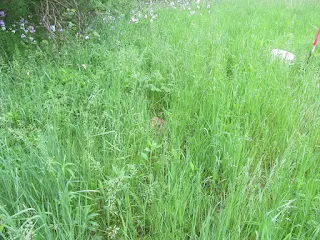 |
| Can you see it? |
 |
| How about now? |
There are undoubtedly hundreds, if not thousands of species of parasitoid wasps. They are just now getting attention for purposes like stopping the Emerald Ash Borer and Chestnut Gall. For the OCD, the difference between parasitic and parasitoid is that the parasitic control leaves the host alive but debilitated. The parasitoid flat out kills the host.
The current research suggests that providing suitable nectar sources can extend the effective lifespan of parasitoid wasps by a factor of three.
Anybody who has hung out near a prime nectar source like rhubarb or horseradish quickly realizes that they pull them into the orchard like a beacon.
Key Points: Prime nectar/pollen plants
- Increase the number of parasitoid wasps in your orchard,
- Are a critical resource that makes them live three times longer
- Provides parasitoid wasps with nutrients so they have the energy to find pests and lay eggs on them
- Pests that migrate in from surrounding areas can be whittled down if prime nectar sources are planted along their infiltration routes
This is what blooming horseradish looks like. In a perfect world I would have varieties with bloom times that spanned from the end of apple blossom until after the plum curculio (an insect pest) pressure ended.
 |
| A plum curculio and the crescent shaped scar it leaves when it lays an egg in a young fruit. |
The plum curculio is the hardest pest to control in Eastern orchards. It shrugs off most easily available pesticides.
According to data from New Jersey, first egg laying was seen at approximately 300 Growing Degree-Days and peaks at about 400 Growing Degree-Days. At this time, south-central Michigan is sitting at about 340 GDD b50. That is about five days behind the long-term average.
 |
| This tells me that I need to get off my dupa and spray my apple trees with Imidan tonight. |
Typically, I would expect to start seeing heavy plum curculio damage on my apples around June 1.



It's always a battle. Some years you win, some years the pests win, but anything you can do to move the bar in your direction is good!
ReplyDelete